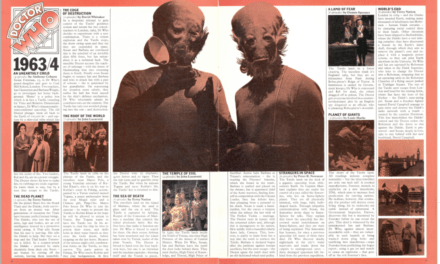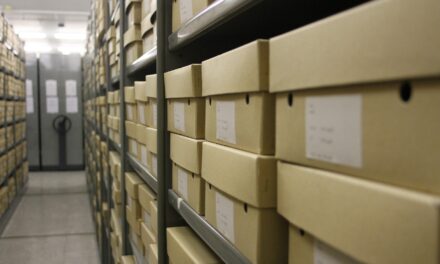Towards the end of last year I had the privilege of taking part in a panel on LGBT characters in science fiction television at the BFI Southbank as part of their Days of Fear and Wonder season. Chaired by Emma Smart the panel—myself, Stacey Abbott and Ewan Kirkland—offered some thoughts on the topic and then took questions, largely from the audience. The discussion was lively and engaging, and the panel certainly had the best title ever: Gays of Fear and Wonder. Preparing for and participating in the panel raised several issues about how I, and others, engage with, are affected by, and remember television and this blog reflects on these.
The panel was billed as a ‘celebration’ of LGBT characters in SF television and this was quite liberating. As well as publishing on representation, I have taught it in classes for many years and have a tendency at times to be overly critical and at others to be somewhat defensive. Being asked specifically to celebrate representation caused me to take a different approach, aligned as much with my identity as a TV viewer, science fiction fan, and feminist with a personal interest in non-conforming gender/ sexual identities, as with my academic teaching and research. When teaching both science fiction and horror, I generally explain to students that they will find me talking sometimes as an academic and sometimes as a fan, and that these are not necessarily distinct or oppositional positions. In the case of the BFI panel, the academic presenters were all aware of their fan identities as well as their academic credentials and I would suggest that both were necessary to establish us as ‘experts’ to the large audience.
One of the issues discussed was why science fiction television, rather than cinema, might offer more diversity and push harder to expand representation. Science fiction, dealing with strange new worlds and alien life forms has plenty of potential for non-normative representation. Science fiction fans are often drawn to the genre because it seems to tell stories about outsiders, making those apparently on the margins more central. While in mainstream media like television or Hollywood movies, this potential may not always go as far as in other, more niche forms of the genre. TV, especially long form serial drama, does offer further potential for challenging heteronormative representation because its narratives are ongoing rather than moving towards closure. TV is still frequently associated with the domestic and is seen, in the UK and many other countries, as mundane and ordinary. Thus, it also has potential for making LGBT characters part of everyday life, even for those who may not know any LGBT people in reality.
Long-running series like Star Trek and Doctor Who have been criticised for having no out gay characters among their main cast. However, there have always been science fiction characters with large gay followings—see the many blog posts from male science fiction fans titled ‘Servalan made me gay’ or equivalent (Blake’s 7, 1978-1981)—despite them being presented as nominally heterosexual in the narrative. My mentioning Servalan clearly struck a chord with some audience members, and at least one person spoke to me afterwards about it, reinforcing my sense of how strongly such characters can influence us.
Each panellist offered a short presentation and mine focused on female characters who were lesbian or bisexual and looked at examples 20 years apart to see how things have changed. I touched on the difficulty in negotiating the presentation of a non-heteronormative character: can they be overtly homosexual, without having sexuality define the character and become an ‘issue’? Subtext, slash and ‘shipping’ have been around for some time but contemporary audiences seem to be demanding more. LGBT characters and relationships that remain only subtextual might once have been welcome (as better than nothing) but now may simply lead to accusations of queerbaiting. With legislation in some countries having moved on, granting and protecting rights for real world LGBT people, audiences might well expect more than they did a few decades ago.
I unashamedly selected some of my personal favourites—characters and series that had influenced me when I watched them and my first was Commander Susan Ivanova from Babylon 5 (1994-1998). While looking online for images of Ivanova, I laughed out loud at one with the caption, ‘Damn Straight’. This is presumably intended as a comment on Ivanova’s no-nonsense personality but given her intense relationship with telepath Talia Winters in season two, it seems rather inappropriate as a description of her sexuality. This relationship is, admittedly, subtextual—the two are never seen kissing—but scenes in ‘Divided Loyalties’ (2.19) present them as a couple and Talia sleeps over in Ivanova’s quarters.

Andrea Thompson, the actor playing Talia left the series soon after, otherwise this might have been developed in a more overt fashion.
Star Trek: Deep Space Nine (1993-1999) did things slightly differently. In ‘Rejoined’ (4.5), regular character Jadzia Dax meets Lenara Khan when the latter comes to the space station on a scientific mission. Jadzia tells a colleague, ‘I know her. She used to be my wife.’ Jadzia Dax is a conjoined Trill, consisting of a host and a long-lived symbiont. The Dax and Khan symbionts were a couple when Dax was joined with a male host: Torias Dax was married to Nilani Khan. In this sense, the relationship both remember was a conventional heterosexual relationship, now complicated by the two symbionts inhabiting different hosts. Trill society has a ‘taboo’ on taking up an old relationship, which is seen as ‘unnatural.’ Thus although, gender is not identified as a ‘problem’ here, the language used in the episode to discuss social attitudes to reviving past relationships clearly keys into familiar homophobic prejudice.

Dax wants to reunite and risk the consequences but Khan does not, and leaves, making this a one-off, unfulfilled romance like most other lesbian kiss television episodes from the 1990s. Programmes ranging from UK soap Brookside 1982-2003 to US sitcom Rosanne 1988-1997, and series L. A. Law 1986-1994 all featured similar, single-episode lesbian kiss stories usually involving a guest character who only appeared in this one episode. Yet, although these episodes could be seen as tokenistic or simply as a cynical ratings ploy rather than as a conscious move towards more diverse representation, the responses of those in the audience when the Deep Space Nine clip was shown during the BFI event suggested that they nevertheless had a lasting impact on viewers and remained memorable moments.
So have things changed? A lesbian kiss between recurring Doctor Who (2005-?) characters Madame Vastra and Jenny was included in the most recent season, during August 2014. Vastra and Jenny debut in ‘A Good Man Goes to War’ (6.7), and reappear in 2012’s Christmas special ‘The Snowmen’ with Vastra’s line, ‘I’m a lizard woman from the dawn of time and this is my wife,’ making them firm favourites for some. Their on-screen kiss in ‘Deep Breath’ (8.1) received only 6 Ofcom complaints, and these were not upheld. Despite the low number of complaints it attracted some press coverage and indicates how science fiction television series may have to negotiate areas of audience and scheduling in relation to representations of sexuality. Because Doctor Who airs in the UK on a mainstream channel in an early-evening time slot and is taken by some as a ‘kids’ show, or at least as family-friendly viewing, various strategies worked to make the ‘kiss’ acceptable. It has a narrative justification—Vastra shares oxygen with Jenny to prevent her being identified by villains who can detect breathing—though given they are married, the assumption is that they might regularly kiss without such excuses.

Also, Vastra and Jenny are an interspecies couple, allowing, perhaps, a bit of distance from a ‘real’ lesbian relationship. Responses from viewers quoted in an article from the Independent varied, with some expressing incredulity that the scene was any cause for comment.
My final example was a series that, as it turned out, many in the audience had not seen, and one I have mentioned here before. Canadian production Orphan Black, (2013-?) focuses on identity, especially female identity: as its premise involves cloning this sense of identity is various and multiple, with different clones (all played by Tatiana Maslany) experiencing different family structures, and performing a range of sexualities and gender identities. One of the clones, bisexual or lesbian Cosima, is in a relationship with (straight) Delphine, who acknowledges, ‘as a scientist I know that sexuality is a spectrum, but social biases codify sexual attraction, contrary to the biological facts’ (‘Entangled Bank’ 1.8). Moreover, as Cosima herself points out, ‘My sexuality’s not the most interesting thing about me’ (‘Governed by Sound Reason and True Religion’ 2.2). While the series does not shy away from depicting lesbian sexuality onscreen, Cosima is characterised and differentiated from the other clones through her intellect, her ability as a scientist, and her geek persona rather than as ‘the lesbian’.

The series continues to emphasise diversity and 2014’s season two introduced, albeit as a one-episode ‘guest’, ftm transgender clone Tony (‘Variable and Full of Peturbation’ 2.8, image from Laura Black’s TV Recap).

The fact that the BFI Gays of Wonder event was all but sold out weeks before it took place is evidence that some people care about LGBT representation on television, enough to pay to attend an event that did not offer TV celebrities or industry insiders, but simply provided an opportunity to hear about and discuss LGBT science fiction characters. The conjunction of science fiction’s estranged alien perspective and the mundane everydayness of television is a powerful combination. As the panellists and the audience shared their fondness for, and frustration with, LGBT characters past and present, the extent to which television is closely tied to cultural and personal memory, and can have a significant effect on how we think about and think through issues related to society and to our own personal lives was demonstrated. Back in the 1990s it may have been ‘hard to believe it’s taken us this long to get to this point’; now, in today’s TV landscape, with a trans female in a non-science fiction series nominated for Best Guest Actress Emmy, ‘Really, none of this should surprise you anymore.’ There was some discussion with the audience at the event about how science fiction fans and those invested in seeing sexual and gender diversity on TV might not be representative of the general population, yet such a shift is still worth celebrating. Here’s hoping 2015 brings more gays of wonder.
Lorna Jowett is a Reader in Television Studies at the University of Northampton. She is the co-author with Stacey Abbott of TV Horror: Investigating The Dark Side of the Small Screen (2013) and author of Sex and the Slayer: A Gender Studies Primer for the Buffy Fan (2005). She is currently writing a book about gender in the new Doctor Who universe.




